Comments from the Chair
West Texas radioactive waste dump
Nuclear waste is again a hot issue for us. Waste Control Specialists (WCS) is a company in Andrews County in far West Texas. The company was founded by Texas billionaire Harold Simmons who donated millions to Rick Perry while WCS was being licensed. Mr. Simmons is now expired and WCS may be bought by a competitor, if anti-trust concerns are overlooked...WCS first promised to accept only chemical hazardous waste, then promised to accept only “low level radioactive waste” (LLRW) from nuclear power plants in Vermont and Texas, then other LLRW, and is now seeking “high level radioactive waste” (HLRW) from power plants throughout the country. This waste is primarily spent nuclear fuel rods.
These intensely radioactive materials are currently stored on site at the hundred or so nuclear plants in the US, four of which are in Texas. The Department of Energy (DOE) is looking for a “consent based” site for “interim storage” of this waste until a permanent storage repository can be developed. Read the Texas Tribune's report, Will Texas become final resting place for high-level nuclear waste?.
There are many reasons why Sierra Club believes “interim storage”, and storage in West Texas in particular are bad ideas. (Background resources can be found at No Nuclear Waste Aqui!). The nuclear power industry is eager to offload their responsibility for storing this material. Once “interim storage” is created it could spur further nuclear power development sought by the industry. Once an interim storage site is created there will be little incentive (and less funds) for development of a permanent repository.
It is highly likely that “interim” will become de facto “permanent”, without providing the standards for long term (hundreds to thousands of years) safety and security required of a permanent repository. The storage site in West Texas (which I have toured) is only 2 miles from the town of Eunice, New Mexico and the area is subject to severe storms, heat, and even has earthquakes. The Ogalala aquifer, the largest in the US, is thought by some to be under this site.
Storage of HLRW in Andrews County would require transport of thousands of casks of this material, by train and/or truck, from sites all over the country. San Antonio is included in the major potential transport routes for this material. A potential accident and spill of this material could jeopardize the lives of thousands of citizens. A terrorist diversion/release is also a serious threat. And if a permanent repository ever is developed elsewhere, the transport of all this highly radioactive material would be required a second time.
On site storage within the secure confines of nuclear power plants has proven the safest “interim storage” solution and should be continued while efforts to develop a permanent repository should be redoubled (while taking measures to reduce and eliminate further HLRW production by building no new nuclear plants and gradually shutting down all existing plants).
WCS has a now complete application with the Nuclear Regulatory Commission. Comments on this are now being accepted, but only until Mar 13, 2017 11:59 PM ET. I urge all interested persons to write and oppose this application. Consent should include those potentially affected by all this transportation, and we in the San Antonio region do not consent.
Editors note: Breaking news! Read County Commissioners Say NO to Shipments of Radioactive Waste below.
Vista Ridge pipeline
SAWS and Vista Ridge continue to move forward. (Lots of background resources available at our Vista Ridge Pipeline: Information Clearinghouse webpage). The calendar for coming contractual “deadlines” includes the following: January 6, 2017, SAWS and the Project Company would finalize the site plan for the terminus site to see if any efficiencies could be achieved. SAWS portion of the terminus site would be conveyed to SAWS by March 13, 2017. The Project Company had deadlines for acquiring the two-acre sites around each of the wells, at the well fields at Burleson County and the permanent collection pipeline easements by June 10, 2017.
Politics
Our political committee has sent questionnaires to candidates and is setting up interviews. We are co-sponsoring a mayoral forum on environmental and social justice issues March 9th. Read our announcement below. We hope to hold a fundraiser for the Sierra Club PAC to help with our support of selected local candidates. We need volunteers to help with all this, and organizing, phone banking etc!
At the national level, the Oklahoma Attorney General (who has sued EPA almost as often as Greg Abbott did as AG) is the nominee for EPA Administrator. Legislation has also been introduced in Congress to eliminate the EPA entirely. There is also legislation to open many parks and federal lands to oil and gas drilling and other mineral development (including Grand Teton and Mesa Verde National Parks for example).
Energy
CPS Energy held an energy forum in February. Mention was made of nuclear energy; however, reassurance was subsequently provided to us that there are NO plans for any additional nuclear power in CPS energy portfolio. CPS continues to work respectfully with us and remains committed to continued reduction in fossil fuel use and emissions, regardless of regulatory changes at the federal level.
by Terry Burns, M.D., Alamo Group Chair
Drinking Water From Air

This month, our General Meeting speaker is Moses West of AWGTechnology. He will discuss the development of atmospheric water generation (AWG), a technology for extracting water from humid air.
Tuesday, March 21st
6:30 p.m.
William R. Sinkin Eco Centro, 1802 North Main Avenue
Map
Mr. West's presentation will call our attention to indications that AWG will be a necessity in the future, how the technology is a viable resource and can supplement traditional freshwater resources, the future of water in the State of Texas and the use of AWG to provide a cost-effective alternative source of water. In addition, he will discuss how atmospheric water generation can be implemented on a small or large scale.
Moses A. West is the CEO of AWGTechnology™ and is a retired Military Officer, Army Ranger and Test Pilot. He originated the patented "AWG Systems and Methods Process" to produce water.
Clearcutting Bills Threaten Texas Trees
It is important for Sierrans to take action to stop the Legislature's war on trees. Texas Senators have filed 3 bills that could effectively abolish San Antonio’s Tree Preservation Ordinance, and every other such ordinance in the state.
If any one of these bills is passed, it will enable mass clearcutting of trees (even giant heritage oaks) for new strip malls and subdivisions:
- SB 782 by Donna Campbell (R-New Braunfels) — Prohibits cities from regulating tree clearing but allows fees to be assessed for planting new trees.
- SB 898 by Paul Bettencourt (R-Houston) — Prohibits cities from regulating tree clearing or assessing mitigation fees.
- SB 1082 by Konni Burton (R-Fort Worth) — Prohibits cities from regulating tree clearing or assessing mitigation fees.
Note the similarity of the bills. This is unusual and a sign that multiple bills were filed to increase their chances of passage. San Antonio’s trees are in grave danger.
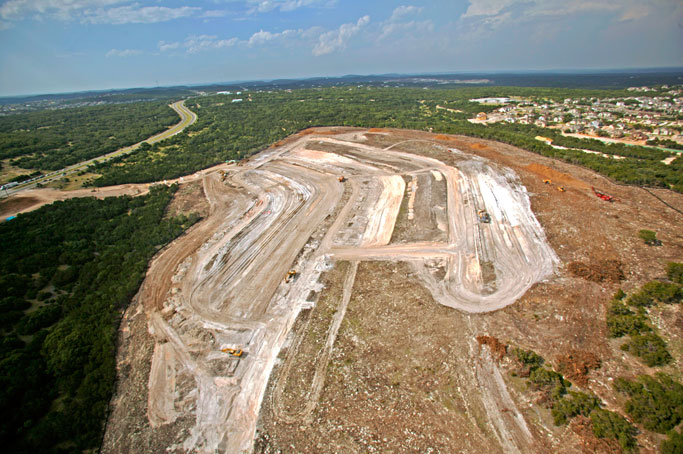
How you can help
- I urge you to contact your state Senator and Representative in strong opposition to these bills.
- Contact the members of the Senate Committees hearing these bills. The bill history pages linked above will list the committees and hearing dates once they are assigned. I recommend setting up email alerts at MyTLO (TX Legislature Online).
- Attend the hearings in Austin to speak in opposition to or register against these bills. Please call me at (210) 494-2088 if you would like a ride to a hearing.
by Richard Alles, Forests/Trees contact
Climate Action SA: San Antonio Needs a Climate Action Plan NOW!
Both the Lone Star Chapter and Alamo Group of the Sierra Club are active members of the Climate Action SA coalition. We urge you to learn more about our goals and help us reach them by signing the petition and encouraging others to support it, too.
The SA Tomorrow planning process has thus far included no Climate Action plan, even though many of the measures in the current planning document address making San Antonio more resilient in the face of Climate Change. It is in our city’s best interest to support solutions that will reduce greenhouse gas emissions that drive global climate change.
Such a Climate Action plan would set goals for reducing greenhouse gas emissions from activities within San Antonio and would establish specific actions across all sectors to meet those goals. A number of organizations and community leaders are coming together to make this happen, but there are still several hurdles to clear and we need your help.
By early April, we hope to get thousands of signatures to our petition that reads:
To the San Antonio Mayor, City Council and Office of Sustainability: Climate change is a serious problem for all San Antonians. Flooding, drought, and extreme heat are making life in San Antonio more difficult and more expensive for everyone, especially those on fixed and low incomes. What’s more, pollution from fossil fuels is disproportionately impacting people of color, our children with asthma and seniors suffering from respiratory illnesses.
To begin addressing this problem, I call on the City of San Antonio to allocate adequate funding to develop a Climate Action Plan that sets clear goals for reducing citywide greenhouse gas emissions in every sector and establishes specific action items that will make meeting those goals possible. Meaningful public participation should drive the development of the plan, and goals should be set based on the scientific consensus on climate change. Co-benefits — such as reduced local air pollution — should be identified in the plan. Climate change is a global problem, but cities — especially large cities like San Antonio — must be a significant part of the solution.
Signatories do not have to be San Antonio voters, but can be anyone who lives in the CPS Energy service area. You can sign the petition online. If you have the opportunity for collecting names (not signatures, but printed names & relevant information for getting the attention of City Council and the Mayor, please print this pdf file.
by Meredith McGuire, Conservation Committee co-chair
Bears Ears National Monument!
President Obama proclaimed Bears Ears National Monument December 28th. This one is 1.35 million acres and protects a big area in southeastern Utah south and east of Canyonlands National Park, and north and east of Glen Canyon National Recreation Area, and includes much of Manti-La Sal National Forest. Have a look at the map. The Bears Ears are a pair of buttes near the center of the monument.
This monument protects 100,000+ Native American habitation sites ranging from 700 to 14,000 years old, and an amazing widespread collection of mesas and canyons that have become increasingly popular for backcountry travel in recent decades. Five Native American tribes formed the Bears Ears Coalition in support of the designation. Visit the coalition's website to read about ancestral and modern day usage, the region to the native eye, threats to the land, and an inspiring document, Bears Ears: A Native Perspective.
Under siege
It is possible the current president will try to reverse the designation of this monument; here's an NPR article. According to ThinkProgress, Congressman Jason Chaffetz (R-Utah) met with Trump on February 7th. Chaffetz’ opposition to the Bears Ears national monument was “subject number one.”
There are various websites complaining about "Obama's land grab". But all this was federal land to begin with, under the jurisdictions of the US Forest Service and Bureau of Land Management. The monument is jointly managed by USFS and BLM. The objections to the designation include the protection from minerals exploitation and additional OHV (Off Highway Vehicle) use, which both can be very destructive to the land, but the latter will continue to be allowed on existing routes.
Fortunately, outdoor gear companies are pushing back. Patagonia is launching a campaign to flood Utah Governor Gary Herbert's office with comments in favor of Bears Ears National Monument. See Patagonia Launches Campaign to Defend Bears Ears from Utah Politicians on the Outside website.
Also under threat from the current president could be Grand Staircase-Escalante National Monument, a few hours drive to the west, even larger at 1.87 million acres, created in 1996 by President Clinton. But that's another large story.
Exploring the monument
The Bears Ears monument map doesn't show much detail. But to mention just a few of the areas that would take years to explore: Cedar Mesa and Valley of the Gods (1st picture below) in the south section of the monument; White Canyon in the west (2nd picture below); Comb Ridge in the east, and the approaches to Canyonlands National Park Needles District to the north (3rd picture below). The Bears Ears Coalition website has a good interactive map with details on these areas.
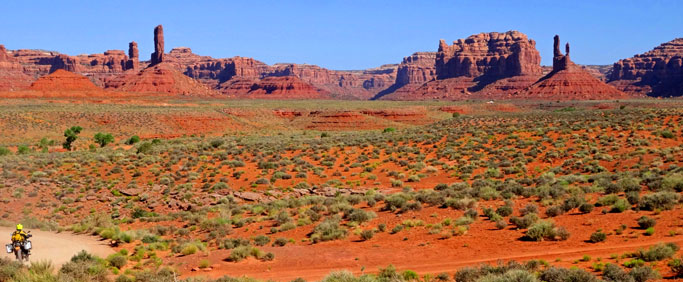
Note on the monument map that Natural Bridges National Monument (National Park Service) is located near the center of the monument though is not part of it. Three of the largest natural bridges (as opposed to arches) in the world are here. All are accessible by short hikes from the loop road, or via a nice 8 mi loop hike which goes under the bridges. There is a small usually full campground, but primitive campsites are easily accessible outside Natural Bridges, and there is a bigger campground at Hovenweep National Monument a few hours to the east. Hovenweep is a great place to visit itself.
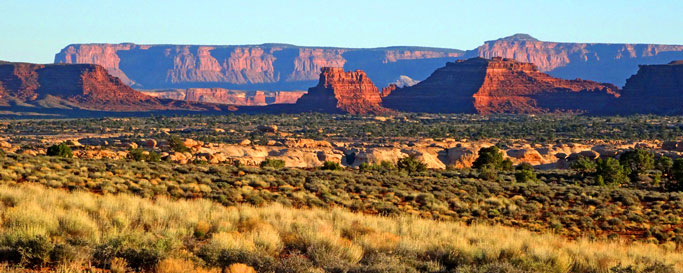
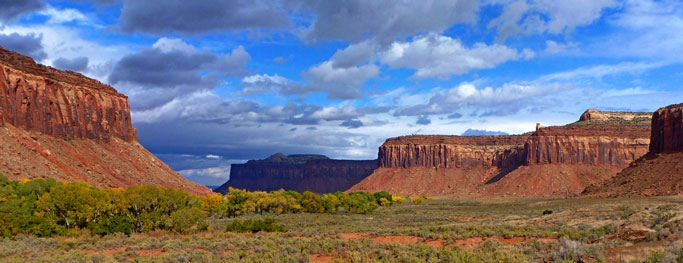
Worth particular mention is Cedar Mesa, comprised of 400+ square miles of the monument, almost 1/5 of the total area. Off the top of the mesa drain a bunch of canyons, including Arch, Mule, Owl, Fish, John's and Slickhorn to name a few. To the southeast is Valley of the Gods and to the southwest are the goosenecks of the San Juan River. To the northwest lies Natural Bridges.
A major canyon draining Cedar Mesa is Grand Gulch, which is a 21 mile (3 or 4 day) backpack, shuttle required. The usual Grand Gulch route is from Kane Gulch ranger station with exit Bullet Canyon. There is a good 16 mile dayhike or overnight (some scrambling required but no serious exposure) including Sheik's and Bullet Canyons and the bit of Grand Gulch between, with primitive camping at both canyon heads.
Further information
If you do Internet searches for the place names mentioned above you will find a wealth of stuff. A few good general resources include americansouthwest.net, desertusa.com, summitpost.org and hikingwalking.com.
Camping is allowed most places on the BLM land. In addition to the developed campgrounds at Natural Bridges and Hovenweep mentioned above there are a couple BLM campgrounds on Hwy 211 on the way into Canyonlands Needles District (the Needles campgrounds may fill before noon). And Goosenecks State Park (see the 4th picture below). And campgrounds along Hwy 95 in Glen Canyon NRA.
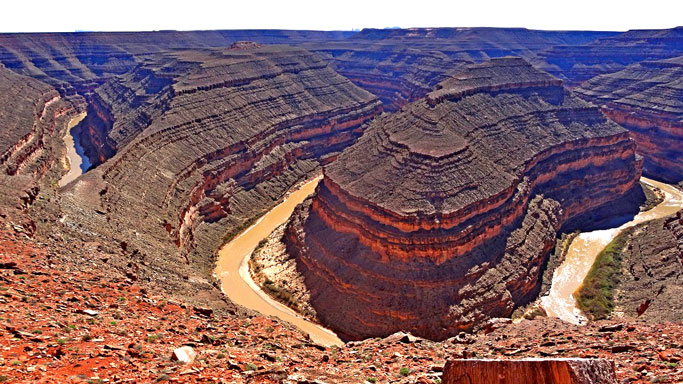
Some of the unpaved roads are impassible when wet, particularly Valley of the Gods and maybe Comb Wash (west side of Comb Ridge, as opposed to Butler Wash on the east side; the latter doesn't have deep sandy spots). The Moki Dugway (fun pics on that website) is a long, 10% grade, winding, narrow section of Hwy 261 just north of the west end of Valley of the Gods Road, north of Mexican Hat; big trailers and RVs would not be good.
by Kevin Hartley, Alamo Group Outings leader
County Commissioners Say NO to Shipments of Radioactive Waste
On February 21, Bexar County became the first county in Texas to officially oppose the transport of high-level nuclear waste (by highway or railway) through Bexar County to a temporary repository in West Texas, according to an article by Brendan Gibbons (SA Express-News, 2-22-17).
The Alamo Group of the Sierra Club was well-represented, along with other local residents from Energía Mía, in the delegation that spoke out in Commissioners Court in support of the resolution sponsored by Tommy Calvert, Precinct 4 Commissioner. Thanks, Tommy! Thanks, also, to Tom “Smitty” Smith of Public Citizen and Karen Hadden of the SEED Coalition, whose careful analysis and tenacious monitoring of this developing problem have been extremely valuable for many years.
Also see Brendan Gibbons’ outstanding article in the Express-News of February 25: Where will our nuclear waste go?. Thanks, Brendan, especially for showing the human face of “we do not consent” sentiment in Andrews and vicinity.
by Meredith McGuire, Conservation Committee co-chair
SA Mayoral Forum on Environmental & Social Justice Issues
The Alamo Group of the Sierra Club is co-sponsoring the SA Mayoral Forum on Environmental & Social Justice Issues
Thursday, March 9th
6 - 8 p.m.
Chapman Center Auditorium at Trinity University, E. Rosewood Ave, San Antonio, TX
There are 25+ co-sponsors -- environmental, social justice, and civic engagement organizations; Sierra Club has prepared some of the questions the Moderator may use in running this forum. Visit the Forum's Facebook page for additional information.
This appears to be the only Mayoral Forum that is focused on specific issues facing the city. It is an excellent chance for voters to see how well the candidates handle the issues when there's more time for critical analysis and arguments based on substance.
by Meredith McGuire, Conservation Committee co-chair
High Speed Rail Connecting Houston and Dallas May Become a Reality
On Thursday, February 16th, Dr. David Hagy, of Texas Central Partners, gave a presentation at the UTSA campus downtown on the Texas Bullet Train, a high speed rail (HSR) that is being planned from Houston to North Texas. The plan will be paid with private investment dollars. The presentation was sponsored by UTSA's Center for Urban and Regional Planning Research and the Graduate Program in Urban and Regional Planning, and the National Association of Railroad Passengers. Dr. Hagy has 20 years managing projects, and has worked at Booz, Allen, and Hamilton, the US Department of Defense, as well as the Department of Justice, and more.
First in the US?
There is no HSR in the United States. Dr. Hagy relayed that the project is seven years old, given the front end work that has occurred to make it become a reality. The last four years involved ridership studies, and other pre-work done in order to attract investment. Connections were made with Central Japan Railway, where this particularly safe and reliable system has operated for 51 years with no accidents or loss of life. Thirty percent of the route has been purchased already. Houston and Dallas were selected partly because these two large cities are accessed by flat land. A straight and flat route is best for the HSR track. This system runs on steel wheels on rail, and each car is powered electrically separately. Fort Worth residents would also have access.
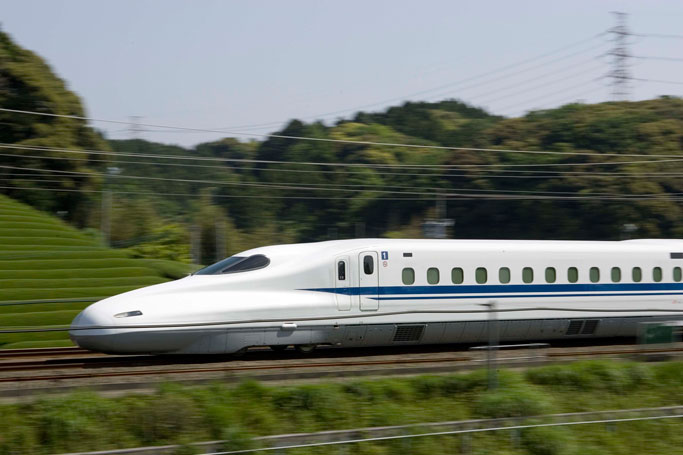
The train will go 200 miles an hour and will take 90 minutes to reach Dallas from Houston, with boardings every 30 minutes. There will be two tracks, and three station stops. The Houston station will be located in NW section of the city. Bryan College Station will be the second one, and the third one will be south of Dallas. The tracks are elevated on a viaduct which makes them simpler and safer to operate. Where there are rural roads to cross, a berm and overpass will be built to carry the train over the road. This is a 240 mile route.
HSR economics
According to Dr. Hagy, the ten billion dollar investment will likely result in over $36 billion return over twenty-five years. Urban development will occur at the stations. When it is up and running, $2.5 billion a year for 25 years will go to cities, counties, and schools along the route.
If Houston and Dallas areas double in size and it takes longer to drive between the cities, the HSR line will be a fast and efficient way to travel. It is anticipated that it would take 6.5 hours to make the drive from Dallas to Houston in five years, which means drivers would be stuck in slow traffic. The train will be ready to roll in 2023.
There will be comfortable seating, with wheelchair space for moving in aisles. According to Dr. Hagy, five million passengers are expected by 2026, and 27 million riders by 2050. Four hundred seats will open every 30 minutes.
A viaduct for the train would be built inside a 150 foot wide right-of-way. This is an efficient way to allow for future capacity increases and enable another train to be added.
Dr. Hagy relayed that this was a public relations presentation. This report about his presentation is only to report progress and is not intended as an endorsement of the bullet train. Dallas and Houston Sierra Club groups may provide additional information.
Learn more about the bullet train on Texas Central Partners' webpage and Facebook page. In addition, read Texas' rural roots and urban future are on a high-speed collision course, How to pay for a $12 billion bullet train without asking Texas for money, and "Come and take it": Eminent domain dispute at heart of bullet train battles in the Texas Tribune.
by Barbara McMillin, Transportation Chair

Outings: The Call of the Wild
Visit the Alamo Sierra Club Outings page on Meetup for detailed information about all of our upcoming Sierra Club Outings.
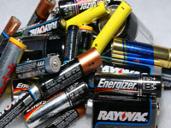
Bring Your Used Batteries to the General Meeting
Don’t throw those small batteries in the trash bin where they will end up in our landfills. Bring them to the monthly general meetings where we will have a container for you to place them in. Thanks to Gay Wright for coordinating this recycling effort.
The Alamo Sierran Newsletter
Richard Alles, Editor
Published by The Alamo Group of the Sierra Club, P.O. Box 6443, San Antonio, TX 78209, AlamoSierraClub.org.
The Alamo Group is one of 13 regional groups within the Lone Star (Texas) Chapter of the Sierra Club.
Keep your email address current!
Send updates to Loyd Cortez, providing your name, address and membership number (if known).
Changed your mailing address?
Have you moved? Let us know by sending your old address, your new address and your member number (look on the upper left corner of your mailing label) to: address.changes@sierraclub.org.
Go online for the latest news and events
 |